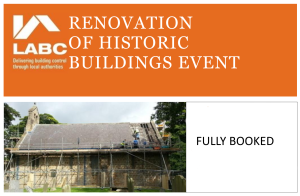 One of IHBC’s new members of ‘Council+’ Rachael Parry, offers a NewsBlog feature update on the Local Authority Building Control’ (LABC) Renovation day in December, in the Hotel Russell, London.
One of IHBC’s new members of ‘Council+’ Rachael Parry, offers a NewsBlog feature update on the Local Authority Building Control’ (LABC) Renovation day in December, in the Hotel Russell, London.
Rachael writes:
‘Local Authority Building Control’ or LABC is a privately run membership led organisation which can represent local authority building control teams in England and Wales. Their members work co-operatively with building owners, homeowners, architects, plan drawers, developers, building contractors and other professionals to ensure buildings are safe, healthy and efficient to meet the standards set by the building regulations.
LABC hold regular CPD training events to keep their members and other interested professionals up to date on changes of the regulations. This conference was predominately aimed at Planning, Building Control and Conservation Officers and professionals from across the private sector with an interest in historic buildings.
The venue, Hotel Russell, was perfectly suited to the the heritage-themes for the day. Completed in 1898, it was designed by Charles Fitxroy-Doll, who was famously known to have designed the interiors within the Titanic. The Hotel is also renowned for it being one of the first hotels in London to be built with ensuite bathrooms. It is beautifully clad in Doultons ‘The aut Lait’ architectural terracotta, with friezes of garlands and cherubs and four statutes of the Queens; Victoria, Elizabeth, Anne and Mary. The interior was equally as attractive with the foyer clad in sumptuous marble decoration with a palatial design and a Pryenean Marble staircase. Delegates enjoyed this even before the formal proceedings started!
Six speakers filled the day with diverse subjects, including IHBC Wales Branch trustee, John Edwards, consultant and lead author of one the key texts for the day, BS 7913, the British Standard on building care and conservation, and IHBC Director Seán O’Reilly.
Colin King opened the conference on a high, he brought up some interesting issues focusing on the document BS5250. He is Director of BRE Wales, and has been involved with some fascinating technical research in to traditional building performance. His recent studies have taken him to review the performance of existing walls along with existing literature and advice. He reported that there was strong evidence from observation to support lower u-values in sold walls following researching air cavities, density and moisture content.
John Edwards talked about the document (and was the lead author of) ‘Guide to the Conservation of Historic Buildings’ BS7913:2013. He stated that there were in England 22% of pre 1919 traditional buildings and highlighted that these perform differently to modern buildings, and how many professionals treat them the same without the understanding and competence of knowledge to apply different approaches. This BS document advises on philosophy, technicalities and the process of dealing with Historic buildings and highlights understanding the significance and applying a technical approach to undertaking works, it is seen to be the most authoritative UK wide building conservation guidance.
Dr Seán O’Reilly gave the audience an insight into the IHBC and the value and opportunities available of the organisation and information on the website.
It was especially useful to hear about the projects being undertaken in Bath from Philip Mansfield, the Building Control Manager at Bath and North East Somerset Council. His case studies showed a variety of systems being placed within listed buildings from Inert gas release systems, replacement glazing, fire curtains, damp proofing, new Equality Act compliant accesses and a fire safety test undertaken on a Georgian terrace. His main message was to ensure that good, practical cooperation between Building Control and Conservation Officers the good will of clients, architects and subsequently contractors results in keeping historic buildings in use and to be able to adapt them to our modern usage requirements whilst still maintaining their historic fabric, character and nature.
Other speakers included Barry Turner and Anna Thompson from the LABC, who led in the organisation of the whole event and rounded off the programme for the day most effectively.
Speakers also offered updates on exemptions and relaxation of Building Regulations when dealing with listed buildings and future working relationships and training for conservation and surveying professionals.
The day as a whole gave conservation professionals the opportunity to mix with the building control/surveying professionals and vice versa. It was especially useful to hear in some examples of where professionals were working together very successful specifically in local authorities, though there were also some surprising comments, questions and answers to the conservation professionals that highlighted the need for more understanding and cohesion between the two practice areas. Hopefully the day will ensure that both disciplines have better communication and working relationship to enable better outcomes and success stories when undertaking works to historic buildings.
NOTE ABOUT THE AUTHOR: Rachael Parry is a member of the IHBC’s new UK-wide forum ‘Council+’. This forum meets twice yearly to help, advise, guide and inform the IHBC’s progress, nationally and locally. It is open to all categories of IHBC membership.
For more on the Council+ see background and links on the NewsBlog Archive and see more on the conference
For more on the LABC see the website
